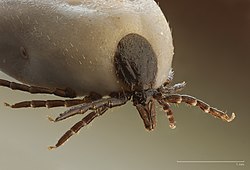Top Qs
Timeline
Chat
Perspective
Ixodidae
Family of ticks From Wikipedia, the free encyclopedia
Remove ads
The Ixodidae are the family of hard ticks or scale ticks,[1] one of the three families of ticks, consisting of 750 species, as of 2025[update].[2] They are known as 'hard ticks' because they have a scutum or hard shield, which the other major family of ticks, the 'soft ticks' (Argasidae), lack. They are ectoparasites of a wide range of host species, and some are vectors of pathogens that can cause human disease.[3]
Remove ads
Description
The Ixodidae are distinguished from the Argasidae by the presence of a scutum.[4] In both the nymph and the adult, a prominent gnathosoma (or capitulum, mouth and feeding parts) projects forward from the animal's body; in the Argasidae, conversely, the gnathosoma is concealed beneath the body.[citation needed]
Ixodidae attach to a host bite painlessly and are generally unnoticed, and they remain in place until they engorge and are ready to moult; this process may take days or weeks. Some species drop off the host to moult in a safe place, whereas others remain on the same host and only drop off once they are ready to lay their eggs.[citation needed]
Remove ads
Classification
Summarize
Perspective
The Ixodidae is divided into two groups: the Prostriata and the Metastriata, distinguished by the position of the anal groove, which is anterior in the former, and posterior in the latter.[5] The Metastriata are further divided into two lineages, Amblyocephalus and Haematobothrion.[6][7] As of 2025, the Ixodidae is composed of 769 extant species in 18 genera, in addition to two fossil genera.[2]
| Ixodidae cladogram after Barker et al., (2024)[8] |

Fossil genera[d]
- †Compluriscutula - 1 species, Poinar and Buckley 2008 Burmese amber, Myanmar, Cenomanian
- †Cornupalpatum - 1 species, Poinar and Brown 2003 Burmese amber, Myanmar, Cenomanian
The Ixodidae is also sometimes classified by its subfamilies, but the current formulations do not encompass all species. There are currently five recognised subfamilies:
- Amblyomminae - comprising Amblyomma.
- Bothriocrotoninae - comprising Bothriocroton.
- Haemaphysalinae - comprising Haemaphysalis.
- Ixodinae - comprising Ixodes.
- Rhipicephalinae - comprising Dermacentor, Margaropus,[17] Rhipicephalus, Rhipicentor, Hyalomma and Nosomma.[e]
Remove ads
Medical importance
Many hard ticks are of considerable medical importance, acting as vectors of diseases caused by bacteria, protozoa, and viruses, such as Rickettsia and Borrelia.[4] Other tick-borne diseases include Lyme disease, babesiosis, ehrlichiosis, Rocky Mountain spotted fever, anaplasmosis, Southern tick-associated rash illness, tick-borne relapsing fever, tularemia, Colorado tick fever, Powassan encephalitis, and Q fever.[20] Ixodid ticks are the primary vectors of tick paralysis, which can affect domestic dogs, cats and livestock, as well as humans.[21]
Notes
- The elevation of Africaniella in 2020, and Cryptocroton in 2024 reduces the count of this genus in Guglielmone et al (2020) by three.[9][10]
- N. keralensis was proposed in 2007, but has subsequently been rejected
- The elevation of Alloceraea in 2024 reduces the count of this genus in Guglielmone et al (2020) by six.[14]
- Other genera, such as Alloceraea and Bothriocroton have recognised paleobiota species
Remove ads
See also
References
External links
Wikiwand - on
Seamless Wikipedia browsing. On steroids.
Remove ads

